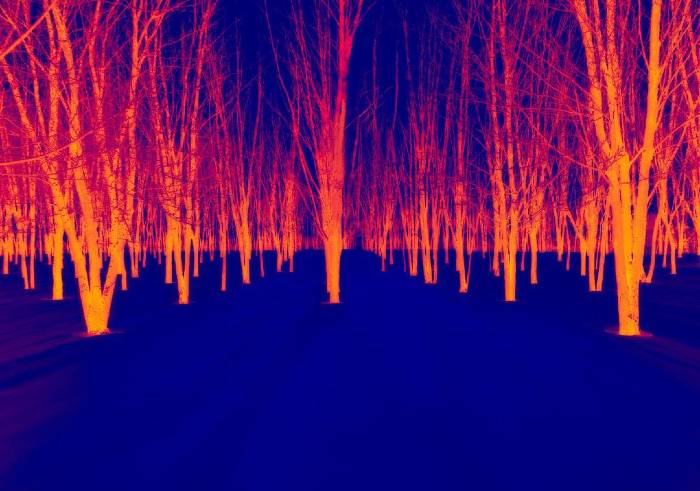Infrared waves, often known as infrared light, are a type of electromagnetic wave. People are exposed to infrared waves on a daily basis, but the human eye cannot perceive them rather they can be detected as heat.
To change channels on your TV, a remote control employs light waves that are slightly outside the visible spectrum of light, called infrared light waves.
This Infrared region spectrum is divided into three parts, namely near-infrared, mid-infrared, and far-infrared. Earth scientists refer to the wavelengths between 8 and 15 microns (m) as thermal infrared because they are best for investigating the long-wave thermal energy radiating from our planet.
How Infrared Was Discovered?
William Herschel conducted an experiment in 1800 to determine the temperature difference between the colors in the visible spectrum. Within each color of the visible spectrum, he inserted thermometers and found that the temperature rose from blue to red. Herschel had discovered infrared light when he found an even warmer temperature measurement just beyond the red end of the visible spectrum.
Significance of Infrared
Thermal Imaging.
Some infrared energy can be perceived as heat. Some objects, such as a fire, are so hot that they also emit visible light. Humans, for example, are not as hot as other objects and only emit infrared radiation.
These infrared waves are invisible to the human eye, but tools that detect infrared energy, such as night-vision goggles or infrared cameras, allow us to “see” infrared waves emitted by warm things like humans and animals. The temperatures in the following photographs are in Fahrenheit.
Spectacular Astronomy With Infrared

Many things in the universe are too chilly and dim to be seen with the naked eye, yet they can be seen in the infrared. By examining the infrared radiation that cooler objects emit such as planets, cool stars, nebulae, and others, scientists are beginning to unravel the mysteries of the cosmos.
The Cassini spacecraft used infrared rays to obtain this image of Saturn’s aurora. The aurora is depicted in blue, while the clouds beneath it are depicted in red.
These aurorae are unusual in the way that they can cover the entire magnetic pole, whereas aurorae around Earth and Jupiter are usually limited to rings surrounding the magnetic poles by magnetic fields.
The enormous and unpredictable structure of these aurorae suggests that charged particles flowing in from the Sun are encountering some type of magnetism above Saturn which was previously unexpected.
How Infrared Can See Through Dust Clouds?
With longer wavelengths than visible light, infrared waves can penetrate through dense gas and dust regions in space with less scattering and absorption. As a result, infrared radiation can reveal objects in the universe that optical telescopes cannot view in visible light.
Three infrared instruments on board the James Webb Space Telescope (JWST) will aid in the study of the origins of the cosmos, as well as the formation of galaxies, stars, and planets.
The illumination from neighboring giant stars illuminates a pillar made of gas and dust in the Carina Nebula, as seen in this visible light image from the Hubble Space Telescope. New stars are forming within the pillar as a result of intense radiation and quick streams of charged particles from these stars.
This is because dense gas clouds hide their light, most of the new stars are invisible in the visible-light image (left). When observed in the infrared section of the spectrum (right), the pillar almost vanishes, revealing the young stars hidden behind the column of gas and dust.
Infrared Earth Surveillance
Infrared sources such as planets are comparatively cool to astrophysicists exploring the universe when compared to the energy emitted by blazing stars and other celestial objects.
Infrared is studied by scientists on earth as a type of thermal emission (or heat) from our planet. When incident solar radiation strikes Earth, some of it is absorbed by the atmosphere and surface, causing the planet to warm.
Infrared radiation is emitted by the Earth to produce this heat. Instruments onboard Earth-observing satellites can detect this infrared radiation and use the data to monitor changes in land and sea surface temperatures.
Lava flows and forest fires are two other sources of heat on the Earth’s surface. Infrared data is used by the Moderate Resolution Imaging Spectroradiometer (MODIS) sensor onboard the Aqua and Terra satellites to monitor smoke and pinpoint forest fire sources.
How Can Infrared Help Saving Lives?
When fire reconnaissance planes are unable to fly through the thick smoke, this information might be critical to firefighting efforts. Scientists can use infrared data to distinguish between blazing fires and still-smoldering burn scars.
The infrared image of the Earth on the right was acquired by the GOES 6 satellite in 1986. Temperatures were utilized to establish which areas of the image were made up of clouds and which were made up of land and sea. He coloured each separately using 256 colors based on the temperature changes, giving the image a realistic appearance.
Why we should use Infrared to Image The Earth?
In the visible range, it is simpler to distinguish clouds from land, but in the infrared region, the clouds have more details which is ideal for investigating the structure of clouds.
Darker clouds, for example, are warmer, whereas lighter clouds are cooler. There’s a spot southeast of the Galapagos Islands, just west of South America’s coast, where you can see many layers of clouds, with the warmer clouds at lower altitudes, closer to the ocean that’s warming them.
Many things emit infrared light, as we can see from an infrared photograph of a cat. However, many items also reflect infrared light particularly near infrared light.
